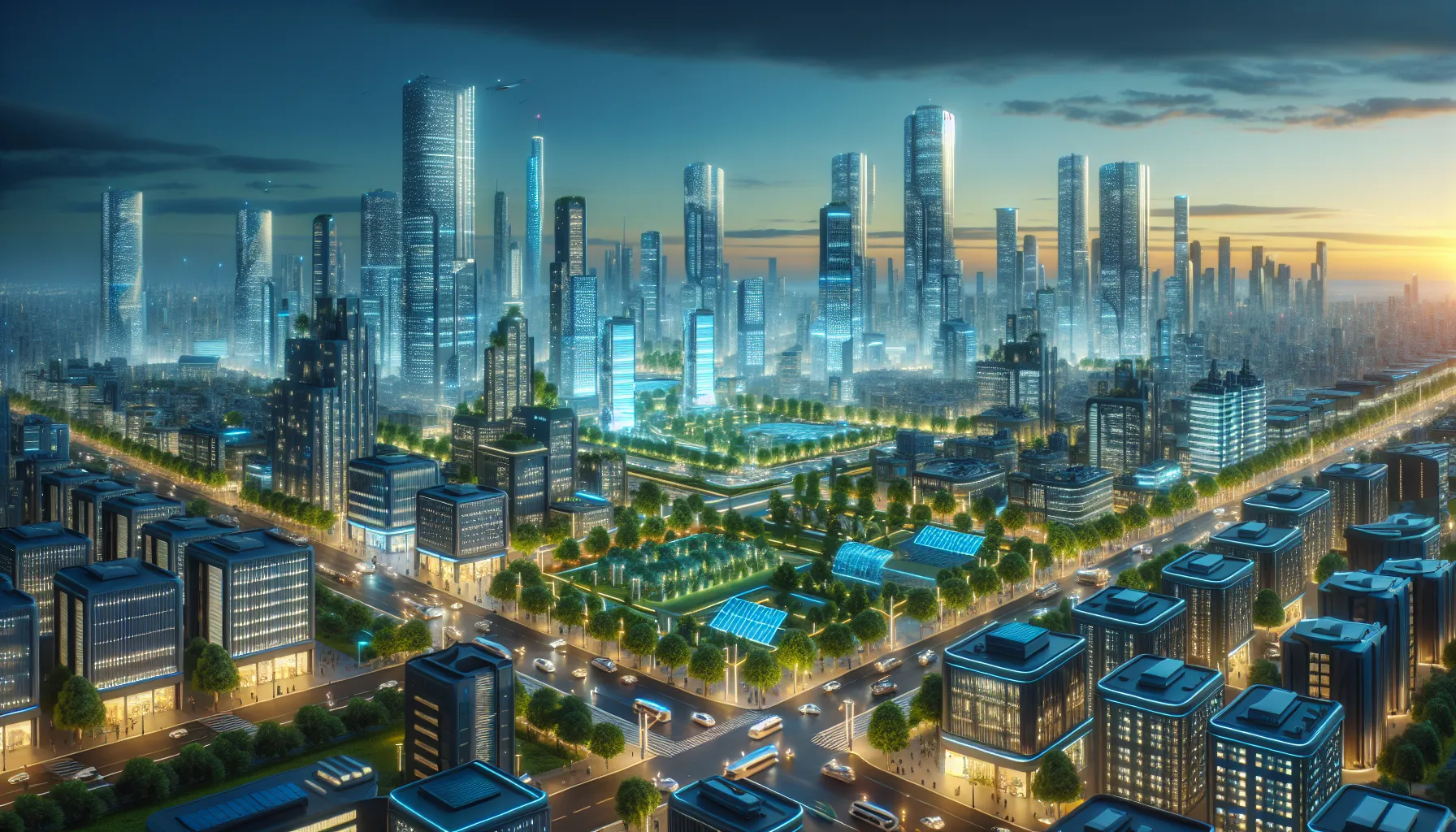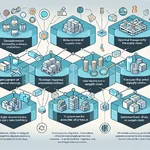In today’s IELTS Reading practice test, we’ll explore the fascinating topic of smart cities and energy efficiency. This subject is increasingly relevant in our modern world, where urban areas are constantly evolving to meet the challenges of sustainability and technology integration. Let’s dive into this comprehensive practice test to enhance your reading skills while learning about innovative urban solutions.
 Smart city energy efficiency concept
Smart city energy efficiency concept
IELTS Reading Test
Passage 1 (Easy Text)
Smart Cities: The Future of Urban Living
Smart cities are rapidly becoming a reality across the globe, transforming urban landscapes and the way we live. These cities utilize cutting-edge technology and data analysis to enhance the quality of life for residents while improving efficiency and sustainability. At the core of smart city initiatives is the concept of interconnectivity, where various urban systems communicate and work together seamlessly.
One of the key components of smart cities is the implementation of Internet of Things (IoT) devices. These devices collect and transmit data about various aspects of city life, from traffic patterns to energy consumption. This wealth of information allows city planners and officials to make data-driven decisions that can significantly improve urban services and infrastructure.
Energy efficiency is a crucial aspect of smart cities. Smart grids play a vital role in managing energy distribution more effectively, reducing waste and optimizing power usage. These advanced electrical grids can automatically adjust to changes in energy demand, integrate renewable energy sources, and even allow for two-way communication between utility companies and consumers.
Smart buildings are another essential feature of these cities. Equipped with sensors and automated systems, these structures can regulate their own temperature, lighting, and energy use based on occupancy and time of day. This not only reduces energy consumption but also enhances comfort for occupants.
Transportation in smart cities is revolutionized through the use of intelligent traffic management systems. These systems use real-time data to optimize traffic flow, reduce congestion, and decrease travel times. Additionally, the promotion of electric vehicles and the development of efficient public transportation networks contribute to reducing the carbon footprint of urban areas.
While the benefits of smart cities are numerous, challenges such as data privacy and cybersecurity must be addressed. As cities become more connected, protecting sensitive information and ensuring the security of critical infrastructure becomes paramount.
In conclusion, smart cities represent a promising solution to many urban challenges, offering a vision of more sustainable, efficient, and livable urban environments for the future.
Questions 1-7
Do the following statements agree with the information given in the reading passage?
Write:
TRUE if the statement agrees with the information
FALSE if the statement contradicts the information
NOT GIVEN if there is no information on this
- Smart cities rely solely on technology to improve urban living.
- Internet of Things devices are essential for collecting data in smart cities.
- Smart grids can communicate with both utility companies and consumers.
- All buildings in smart cities are equipped with automated systems.
- Intelligent traffic management systems use historical data to optimize traffic flow.
- Electric vehicles are the only form of transportation promoted in smart cities.
- Data privacy is a major concern in the development of smart cities.
Questions 8-13
Complete the sentences below.
Choose NO MORE THAN TWO WORDS from the passage for each answer.
- Smart cities aim to enhance residents’ ____ while improving efficiency and sustainability.
- City planners use ____ to make informed decisions about urban services and infrastructure.
- Smart grids can automatically adjust to changes in ____.
- Smart buildings can regulate their systems based on ____ and time of day.
- The use of intelligent traffic management systems helps to reduce ____ in smart cities.
- Protecting ____ becomes crucial as cities become more connected.
Passage 2 (Medium Text)
Energy Efficiency: The Cornerstone of Sustainable Urban Development
The concept of energy efficiency has become increasingly paramount in urban planning and development, particularly as cities worldwide grapple with the dual challenges of rapid population growth and climate change. Energy efficiency refers to the practice of using less energy to perform the same task or produce the same result, a principle that is now being applied on a city-wide scale through innovative technologies and policies.
One of the most significant areas where energy efficiency is making an impact is in building design and construction. Modern buildings are being constructed with energy-conserving materials and equipped with smart systems that optimize heating, cooling, and lighting based on occupancy and external conditions. Retrofitting older buildings with these technologies is also becoming a common practice, significantly reducing energy consumption in urban areas.
Transportation is another sector where energy efficiency is driving change. Cities are increasingly investing in electric vehicle infrastructure, including charging stations and dedicated lanes. Moreover, the promotion of public transit systems and the development of bike-sharing programs are encouraging residents to opt for more energy-efficient modes of transportation. Some cities are even experimenting with smart traffic lights that adapt to real-time traffic conditions, reducing idle time and fuel consumption.
In the realm of urban planning, the concept of the “15-minute city” is gaining traction. This model aims to design neighborhoods where all necessary amenities are within a 15-minute walk or bike ride, significantly reducing the need for energy-intensive transportation. This approach not only conserves energy but also improves quality of life by reducing commute times and fostering a sense of community.
Smart grids are revolutionizing energy distribution in cities. These advanced systems use digital technology to detect and react to local changes in usage, allowing for more efficient distribution of electricity. Smart grids can also integrate renewable energy sources more effectively, managing the intermittent nature of solar and wind power to ensure a stable supply of electricity.
Water management is another area where energy efficiency is making strides. Smart water systems can detect leaks, reduce waste, and optimize distribution, all of which contribute to energy savings in the water treatment and pumping processes. Some cities are also implementing rainwater harvesting and greywater recycling systems to reduce the energy needed for water treatment and distribution.
While the benefits of energy-efficient cities are clear, there are challenges to implementation. The initial costs of upgrading infrastructure and implementing new technologies can be substantial. Additionally, there may be resistance to change from both residents and businesses accustomed to traditional urban systems.
Despite these challenges, the long-term benefits of energy-efficient cities are compelling. Reduced energy consumption leads to lower greenhouse gas emissions, improved air quality, and significant cost savings for both cities and residents. Moreover, energy-efficient cities are often more resilient to power outages and other disruptions, enhancing overall urban stability.
As we move towards a more sustainable future, energy efficiency in urban areas will play a crucial role in mitigating climate change and creating more livable cities. The technologies and strategies being developed and implemented today are laying the groundwork for the resilient, sustainable cities of tomorrow.
Questions 14-19
Choose the correct letter, A, B, C, or D.
-
According to the passage, energy efficiency in cities is becoming increasingly important due to:
A. Technological advancements
B. Population growth and climate change
C. Government regulations
D. Economic pressures -
Modern buildings contribute to energy efficiency by:
A. Using more electricity
B. Increasing occupancy rates
C. Optimizing systems based on occupancy and external conditions
D. Focusing solely on heating systems -
The “15-minute city” concept aims to:
A. Increase commute times
B. Reduce the need for energy-intensive transportation
C. Eliminate all forms of public transport
D. Encourage more car usage -
Smart grids are beneficial because they:
A. Only work with non-renewable energy sources
B. Increase electricity costs for consumers
C. Detect and react to local changes in energy usage
D. Require less maintenance than traditional grids -
In water management, energy efficiency is achieved through:
A. Increasing water consumption
B. Detecting leaks and optimizing distribution
C. Using only rainwater for all urban needs
D. Eliminating water treatment processes -
The main challenge in implementing energy-efficient technologies in cities is:
A. Lack of available technologies
B. Resistance from environmental groups
C. Initial costs and resistance to change
D. Increased energy consumption
Questions 20-26
Complete the summary below.
Choose NO MORE THAN TWO WORDS from the passage for each answer.
Energy efficiency is becoming a crucial aspect of urban development as cities face challenges related to population growth and climate change. In building design, energy-conserving materials and smart systems are used to optimize energy use. The transportation sector is seeing changes with the introduction of (20) ____ and the promotion of public transit. Urban planners are exploring the concept of the “15-minute city” to reduce the need for (21) ____.
(22) ____ are improving energy distribution by integrating renewable energy sources more effectively. In water management, smart systems help detect (23) ____ and optimize distribution. Some cities are also implementing (24) ____ and greywater recycling systems.
Despite challenges such as high (25) ____ and resistance to change, energy-efficient cities offer significant benefits. These include reduced energy consumption, lower greenhouse gas emissions, and improved (26) ____. As we move towards a more sustainable future, energy efficiency in urban areas will play a vital role in creating resilient and livable cities.
Passage 3 (Hard Text)
The Synergy of Smart Cities and Energy Efficiency: A Paradigm Shift in Urban Sustainability
The confluence of smart city technologies and energy efficiency initiatives is ushering in a new era of urban sustainability, one that promises to revolutionize the way cities function and consume resources. This synergy is not merely an incremental improvement but rather a paradigm shift in urban planning and management, offering solutions to some of the most pressing challenges faced by modern metropolises.
At the heart of this transformation is the concept of data-driven decision making. Smart cities leverage an extensive network of sensors and Internet of Things (IoT) devices to collect vast amounts of real-time data on various urban processes, from energy consumption patterns to traffic flows. This data is then analyzed using advanced algorithms and machine learning techniques to identify inefficiencies and optimize resource allocation. The result is a city that can adapt dynamically to changing conditions, minimizing waste and maximizing efficiency across multiple domains.
One of the most promising applications of this approach is in the realm of energy management. Traditional urban energy systems are often characterized by inefficiencies and wastage, with significant disparities between peak and off-peak demand. Smart grids, a cornerstone of energy-efficient smart cities, address this issue by enabling bidirectional communication between energy producers and consumers. This allows for real-time load balancing and the integration of distributed energy resources (DERs), including rooftop solar panels and small-scale wind turbines.
The integration of renewable energy sources is particularly crucial in the context of urban sustainability. Smart cities are uniquely positioned to overcome the challenges associated with the intermittent nature of renewables through the use of advanced energy storage systems and predictive analytics. By accurately forecasting energy production and demand, smart cities can optimize the use of renewable resources, reducing reliance on fossil fuels and mitigating the urban heat island effect.
Another key aspect of the smart city-energy efficiency nexus is the concept of circular economy principles applied to urban resources. Smart waste management systems, for instance, use IoT-enabled sensors to optimize collection routes and schedules, reducing fuel consumption and emissions from waste collection vehicles. Moreover, some advanced systems can sort and process waste automatically, facilitating recycling and even energy recovery from organic waste through technologies like anaerobic digestion.
The transportation sector, a significant contributor to urban energy consumption and emissions, is undergoing a radical transformation in smart cities. Intelligent transportation systems (ITS) use real-time data to optimize traffic flow, reduce congestion, and promote the use of public transit and shared mobility options. Furthermore, the electrification of urban mobility, supported by smart charging infrastructure and vehicle-to-grid (V2G) technology, is creating new opportunities for energy efficiency and grid stability.
Buildings, which account for a substantial portion of urban energy consumption, are becoming increasingly intelligent and efficient. Smart building management systems (BMS) use a network of sensors and actuators to optimize heating, cooling, lighting, and ventilation based on occupancy patterns and external conditions. Some advanced systems even incorporate predictive maintenance algorithms, identifying potential equipment failures before they occur and thus preventing energy waste.
While the potential benefits of integrating smart city technologies with energy efficiency initiatives are immense, there are significant challenges to overcome. Interoperability issues between different systems and platforms can hinder the seamless flow of data and coordination of various urban subsystems. Cybersecurity concerns are also paramount, as the increasing connectivity of urban infrastructure creates new vulnerabilities that must be addressed.
Moreover, the digital divide within cities poses a risk of exacerbating existing inequalities. Ensuring equitable access to the benefits of smart city technologies and energy efficiency improvements is crucial for creating truly sustainable urban environments.
Despite these challenges, the integration of smart city technologies and energy efficiency measures represents a powerful tool for addressing urban sustainability issues. As cities continue to grow and evolve, this synergistic approach will play an increasingly important role in creating resilient, efficient, and livable urban spaces for future generations.
Questions 27-31
Choose the correct letter, A, B, C, or D.
-
According to the passage, the combination of smart city technologies and energy efficiency is described as:
A. An incremental improvement
B. A paradigm shift
C. A temporary solution
D. A theoretical concept -
Smart grids in energy-efficient cities enable:
A. Unidirectional communication between producers and consumers
B. Increased reliance on fossil fuels
C. Real-time load balancing and integration of distributed energy resources
D. Decreased use of renewable energy sources -
The concept of circular economy in smart cities is exemplified by:
A. Increased waste production
B. Manual sorting of waste
C. Optimized waste collection and automatic sorting
D. Reduced recycling efforts -
Intelligent transportation systems in smart cities aim to:
A. Increase traffic congestion
B. Discourage the use of public transit
C. Optimize traffic flow and promote shared mobility
D. Rely more on traditional fuel vehicles -
The main challenge in implementing smart city technologies and energy efficiency measures is:
A. Lack of available technology
B. Interoperability issues and cybersecurity concerns
C. Reduced energy consumption
D. Simplified urban infrastructure
Questions 32-36
Complete the sentences below.
Choose NO MORE THAN THREE WORDS from the passage for each answer.
- Smart cities use ____ to analyze data collected from sensors and IoT devices.
- The integration of renewable energy in smart cities helps mitigate the ____.
- Some advanced waste management systems can facilitate energy recovery from organic waste through ____.
- The electrification of urban mobility is supported by smart charging infrastructure and ____ technology.
- To prevent energy waste, some advanced building management systems incorporate ____ algorithms.
Questions 37-40
Do the following statements agree with the claims of the writer in the reading passage?
Write:
YES if the statement agrees with the claims of the writer
NO if the statement contradicts the claims of the writer
NOT GIVEN if it is impossible to say what the writer thinks about this
- Smart cities can adapt dynamically to changing conditions in various urban processes.
- Traditional urban energy systems are highly efficient with minimal wastage.
- The digital divide in cities may lead to increased inequalities in access to smart city benefits.
- The integration of smart city technologies and energy efficiency measures is unlikely to have a significant impact on urban sustainability.
Answer Key
Passage 1
- FALSE
- TRUE
- TRUE
- FALSE
- FALSE
- FALSE
- TRUE
- quality of life
- data-driven decisions
- energy demand
- occupancy
- congestion
- sensitive information
Passage 2
- B
- C
- B
- C
- B
- C
- electric vehicle infrastructure
- energy-intensive transportation
- Smart grids
- leaks
- rainwater harvesting
- initial costs
- air quality
Passage 3
- B
- C
- C
- C
- B
- advanced algorithms
- urban heat island effect
- anaerobic digestion
- vehicle-to-grid
- predictive maintenance
- YES
- NO
- YES
- NO
Conclusion
This IELTS Reading practice test on smart cities and energy efficiency has provided a comprehensive exploration of these interconnected topics. By working through these passages and questions, you’ve not only enhanced your reading skills but also gained valuable insights into the future of urban development and sustainability.
Remember, success in the IELTS Reading test comes from regular practice and familiarity with various question types. Keep honing your skills by exploring different topics and practicing time management.
For more information on related topics, you might find these articles interesting:
- How Smart Grid Technology is Promoting Energy Efficiency
- Green Energy in Reducing Air Pollution
- [Smart Cities and Data Privacy](https://www.


